There are many types of power quality issues and power problems, each of which have various causes. To further complicate the matter, different power quality problems can occur simultaneously, interchangeably, or randomly. The following is a brief summary of common power problems.
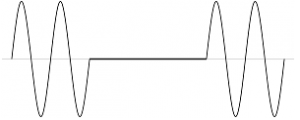 Blackout or Interruption
Blackout or Interruption
An interruption or blackout occurs when the voltage drops below 10% of its nominal value. Interruptions have three classifications: momentary (lasting 30 cycles to 3 seconds), temporary (lasting 3 seconds to 1 minute) and sustained (lasting more than 1 minute).
Although interruptions are the most severe power problem, they are also the least likely to occur. Voltage sags are often mistaken for interruptions because equipment shuts down or lighting goes off when voltage drops below the threshold.
Interruptions represent less than 4% of power problems. Sags and undervoltage typically represent more than 92% of power problems.
Frequency
The U.S. electrical grid operates at 60 Hertz or 60 cycles per second. The “mass” of the U.S. electrical system makes frequency problems unlikely. Virtually all electrical devices are capable of operating properly at frequency variations much larger than those typically seen in the U.S.
Stable frequency does not apply to closed systems where electricity is generated on-site. Even large diesel-generator sets can have frequency problems. (See operating frequency.)
Harmonics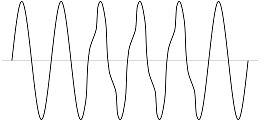
Harmonics are a recurring distortion of the waveform caused by devices including variable frequency drives, non-linear power supplies and electronic ballasts. Certain types of power conditioners, including ferroresonant or constant voltage (CVT) transformers, can add significant harmonic distortion to the waveform.
Waveform distortion can also be an issue with uninterruptible power supplies (UPS) and other inverter-based power conditioners. The UPS does not actually add distortion, but because the UPS digitally synthesizes a waveform, the waveform may become square or jagged rather than a smooth sine wave.
Symptoms of harmonic distortion include overheating and equipment operational problems.
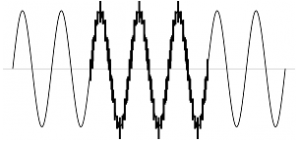 Noise
Noise
Noise is a high-frequency distortion of the voltage waveform caused by disturbances on the utility system or by equipment such as welders, switchgear and transmitters. Noise frequently goes unnoticed. Frequent or high levels of noise can cause equipment malfunction, overheating, and premature wear.
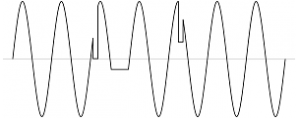 Notching
Notching
Notching is a disturbance of opposite polarity to the normal voltage waveform (subtracted from the normal waveform) lasting for less than one-half cycle. Notching is frequently caused by malfunctioning electronic switches or power conditioners.
Although it is generally not a major problem, notching can cause equipment, especially electronics, to operate improperly.
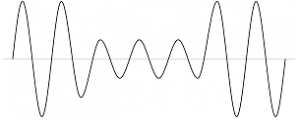 Sag or Dip
Sag or Dip
The American “sag” and the British “dip” are both names for a decrease in voltage to between 10% and 90% of nominal voltage for one-half cycle to one minute.
Sags account for the vast majority of power problems end users experience. They can be generated internally and externally from an end user’s facility.
External sags primarily come from the utility transmission and distribution network. Sags coming from the utility have a variety of causes, including lightning, animal and human activity, and normal and abnormal utility equipment operation. Sags generated on the transmission or distribution system can travel hundreds of miles, affecting thousands of customers during a single event.
External sags can also be generated by other nearby customers. Starting a large electrical loads or switching off a shunt capacitor bank can generate a sag large enough to affect a local area. If the end user is already subject to chronic undervoltage, even a relatively small amplitude sag can be detrimental.
Internal sags are typically generated when starting large electrical loads such as motors or magnets. The large current inrush required to start these loads depresses the voltage level available to other equipment sharing the same electrical system. As with external sags, those generated internally will be magnified by chronic undervoltage.
Short Circuit
A short circuit (or “short”) is not normally considered a quality problem as much as it is a dangerous operational malfunction or fault. Short circuit refers to a condition where two “hot” lines are connected directly (or through a small impedance) or one “hot” line is connected directly to ground.
A short circuit causes very high fault currents to flow through the wiring and all devices between the point of the short and the incoming power line. Left unchecked, a short circuit can very quickly lead to catastrophic overheating, melting and burning of wiring and devices.
To guard against damage from short circuits, open a breaker or operate a protective fuse. It is imperative that protective breakers and fuses be the proper size and have the proper characteristics to avoid short-circuit dangers. (See fault clearing.)
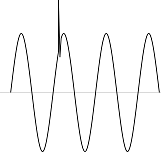 Transient or Surge
Transient or Surge
Transients are very short duration (sub-cycle) events of varying amplitude. Often referred to as “surges,” transients are most frequently visualized as the tens of thousands of volts from a lighting strike that destroy any electrical device in its path.
Transients can be caused by equipment operation/failure or by weather events. Even relatively low-voltage transients can cause damage to electrical components if they occur with frequency.
A properly sized industrial-grade surge suppressor is usually ample protection from the damaging effects of high-voltage transients.
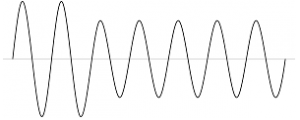 Undervoltage
Undervoltage
Undervoltage is a decrease in voltage below 90% of its nominal value for more than one minute. Undervoltage is sometimes called a “brownout” although this term is not officially defined. Brownout is often used when the utility intentionally reduces system voltage to accommodate high demand or other problems.
The symptoms of undervoltage can range from daily equipment malfunction to premature equipment failure. Undervoltage may go unnoticed until new equipment is installed or the electrical system is changed and the new combined load depresses (see sags) the voltage and symptoms become apparent. Equipment malfunction or chronic undervoltage can cause excess wear on devices, such as motors, which tend to run hot if voltage is low.
Undervoltage is generally a chronic problem aggravated by factors beyond the end user’s control. Electric utilities try to maintain voltage levels delivered to customers at ±5%. Weather, high demand and other factors can cause utility voltage to fall within a ±10% range. Even under ideal conditions, most customers will see a drop in utility voltage levels as demand increases between 8 AM and 4 PM.
Distribution system characteristics can also contribute to chronically low voltage. For example, customers at the end of a long line may be subject to a permanent voltage drop due to line losses on top of utility voltage variations.

